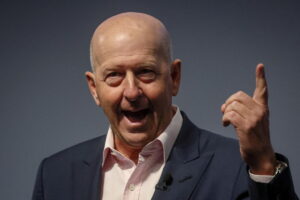Unpacking the Wall Street Excitement: A Shift in Banking as Trump’s Administration Looms
When Goldman Sachs CEO David Solomon received an invitation to witness President-elect Donald Trump ringing the opening bell at the New York Stock Exchange, it wasn’t just a photo op; it was a rendezvous with potential opportunity. Alongside Citigroup CEO Jane Fraser and other top executives, Solomon was presented with a rare chance to rub shoulders with Trump’s cabinet nominees, showcasing the high stakes and strategic networking crucial to financial circles during transitional times.
As the trading floor erupted in celebratory chants of "U-S-A," the mood exemplified the optimism prevailing among major banking institutions. With 2024 drawing to a close, the landscape for financial services is pulsating with promise, as lower interest rates, rebounding deal-making activity, and a favorable regulatory environment appear on the horizon.
The Surge of Financial Markets
Large banks, particularly Goldman Sachs, have good reason to be upbeat. Buoyed by the election results and the prospective looser regulatory framework expected under a Republican administration, Goldman Sachs has witnessed a remarkable surge in its stock price—up 50% in the past year alone. This optimism isn’t isolated to Goldman; other major players such as JPMorgan Chase, Bank of America, Citigroup, Wells Fargo, and Morgan Stanley have also experienced stock increases ranging from 5% to 12%.
JPMorgan Chase CEO Jamie Dimon aptly encapsulated the sentiment when he remarked that bankers were practically "dancing in the street" following Trump’s election win. With expectations set high, JPMorgan is projected to achieve record profits, particularly with a 45% jump anticipated in investment banking revenues for Q4 2024.
Is This the Start of a New Bull Market for Banks?
What has analysts buzzing is the possibility that this rally could signal the onset of a long-awaited bull market for banks, reminiscent of the vibrant years following the Fed’s rate cuts in 1995. The period marked significant consolidation in the banking sector and resulted in monumental growth. A similarly conducive environment, marked by lower interest rates and regulatory easing, could set the stage for banks to thrive.
However, while the current enthusiasm might parallel the optimism of 1995—where the KBW Bank index rose 32%, outperforming most major indexes—sustaining this momentum will depend on several vital factors. Barclays analyst Jason Goldberg has cautioned that "election optimism must translate into bank revenue," hinting at the necessity for a tangible economic uplift rather than just market sentiment.
Investment Banking: Signs of Resurgence
One encouraging sign is that investment banking, which has faced challenges over the past two years, seems to be experiencing a revival. With 2024 projected to yield one of the highest revenue figures for investment banking in the last decade, there’s cautious optimism that the merger and acquisition landscape could flourish. Solomon’s prediction of reaching, or even exceeding, 10-year averages in 2025 underscores that banks might finally be on the cusp of unlocking their full potential.
Navigating the Regulatory Landscape
Yet, all eyes are on the regulatory changes that may accompany Trump’s new administration. Banks are particularly hopeful that the incoming leadership will reconsider capital requirements introduced under Basel III, designed to ensure financial stability but perceived as burdensome. After winning concessions in September to soften some of these rules, the banking sector is optimistic that a friendly regulatory stance will support their growth trajectory.
Challenges Ahead
Despite optimism, uncertainties loom. Trump’s economic agenda—which includes tariffs and tax reforms—could impose inflationary pressures and potentially raise interest rates, making borrowing costlier and complicating financial strategies for banks. Moreover, economists remain watchful of any broader economic volatility that may stem from these policies.
Conclusion: Confidence Among Bank Executives
In an environment filled with fluctuating policies and potential challenges, bank executives like Bank of America’s Brian Moynihan express profound confidence in the U.S. economy under Trump’s leadership, emphasizing the administration’s ability to "hit the ground running." For investors, this balance of hope and caution presents a unique landscape to navigate.
As we delve deeper into the financial markets and craft our investment strategies, staying informed is essential. At Extreme Investor Network, we’re dedicated to providing unique insights and analyses that empower our readers to make informed decisions in this dynamic market climate.

